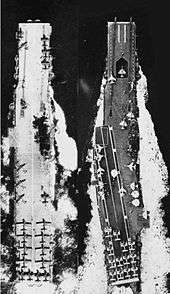USS Intrepid (CV-11)
 USS Intrepid (CV-11) in the Philippine Sea, November 1944 | |
| History | |
|---|---|
| Name: | Intrepid |
| Builder: | Newport News Shipbuilding |
| Laid down: | 1 December 1941 |
| Launched: | 26 April 1943 |
| Commissioned: | 16 August 1943 |
| Decommissioned: | 22 March 1947 |
| Recommissioned: | 9 February 1952 |
| Decommissioned: | 9 April 1952 |
| Recommissioned: | 18 June 1954 |
| Decommissioned: | 15 March 1974 |
| Reclassified: |
|
| Struck: | 23 February 1982 |
| Nickname(s): | "Fighting I", "Dry I" |
| Status: | Museum ship at the Intrepid Sea, Air & Space Museum in New York City. |
| Badge: |
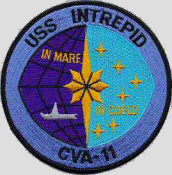 |
| General characteristics | |
| Class and type: | Essex-class aircraft carrier |
| Displacement: |
|
| Length: |
|
| Beam: |
|
| Draft: |
|
| Decks: | 3 |
| Propulsion: |
|
| Speed: | 33 knots (61 km/h) |
| Range: | 20,000 nautical miles (37,000 km) at 15 knots (28 km/h) |
| Complement: |
|
| Armament: |
|
| Armor: |
|
| Aircraft carried: |
|
USS Intrepid (CV/CVA/CVS-11), also known as The Fighting "I", is one of 24 Essex-class aircraft carriers built during World War II for the United States Navy. She is the fourth US Navy ship to bear the name. Commissioned in August 1943, Intrepid participated in several campaigns in the Pacific Theater of Operations, most notably the Battle of Leyte Gulf. Decommissioned shortly after the end of the war, she was modernized and recommissioned in the early 1950s as an attack carrier (CVA), and then eventually became an antisubmarine carrier (CVS). In her second career, she served mainly in the Atlantic, but also participated in the Vietnam War. Her notable achievements include being the recovery ship for a Mercury and a Gemini space mission. Because of her prominent role in battle, she was nicknamed "the Fighting I", while her frequent bad luck and time spent in dry dock for repairs—she was torpedoed once and hit by four separate Japanese kamikaze aircraft—earned her the nicknames "Decrepit" and "the Dry I". Decommissioned in 1974, in 1982 Intrepid became the foundation of the Intrepid Sea, Air & Space Museum in New York City.
Construction and commissioning
Intrepid was launched on 26 April 1943 by Newport News Shipbuilding & Dry Dock Co., Newport News, Virginia, the fifth Essex-class aircraft carrier to be launched. She was sponsored by the wife of Vice Admiral John H. Hoover. On 16 August 1943, she was commissioned with Captain Thomas L. Sprague in command before heading to the Caribbean for shakedown and training.[1] Intrepid's motto upon setting sail was "In Mare In Caelo", which means "On the sea, in the sky", "In the sea in Heaven",[2] or "On the sea and in the air".[3]
Service history
World War II
Intrepid has a distinguished service record, seeing active service in the Pacific Theater including the Marshall Islands, Truk, Leyte Gulf, and Okinawa. At war's end, she was in Enewetak and soon supported occupation forces[1] providing air support and supply services before heading back to California.[4]
Marshalls, January–February 1944
On 3 December 1943: Intrepid sailed from Naval Station Norfolk for San Francisco, then to Hawaii. She arrived at Pearl Harbor and prepared for the invasion of the Marshall Islands, the next objective in the Navy's island-hopping campaign. On 16 January Intrepid left Pearl Harbor with carriers Cabot and Essex. Starting on 29 January Intrepid raided islands in the northeastern corner of the Kwajalein Atoll and by 31 January all 83 Japanese aircraft stationed on Roi-Namur. The first landings were made on adjacent islets. That morning, Intrepid's aircraft strafed Ennuebing Island until 10 minutes before the first Marines reached the beaches. Thirty minutes later, the islet – which protected Roi's southwestern flank and controlled the North Pass into the Kwajalein Lagoon – was secured, enabling Marines to set up artillery to support their assault on Roi. On 2 February Intrepid headed for Truk, the Japanese naval base in the center of Micronesia. On 16 February the Intrepid, as part of Task Force 58, began airstrikes against Truk atoll as part of Operation Hailstone. The Japanese lost several warships and merchant vessels, alongside several hundred aircraft. The carrier raid demonstrated Truk's vulnerability and thereby greatly curtailed its usefulness to the Japanese as a base. On the night of 17–18 February, the Intrepid was struck by a torpedo from a Japanese aircraft. The torpedo struck Intrepid's starboard quarter, 15 ft (5 m) below her waterline, flooding several compartments, distorting her rudder and killing 11 crewmen. By running her port engines at full power and stopping her starboard engines or running them at ⅓ ahead, Captain Sprague kept her roughly on course. Her crew moved all the aircraft on deck forward to increase her headsail to further aid in control.[5] Two days later, on 19 February, strong winds overpowered the improvised steering and left her with her bow pointed toward Tokyo. Sprague later confessed: "Right then I wasn't interested in going in that direction." At this point the crew made a jury-rig sail of wood, cargo nets, and canvas to further increase her headsail, allowing Intrepid to hold her course. Intrepid arrived at Pearl Harbour for temporary repairs on 24 February and departed for the West Coast on 16 March. On 22 March she arrived at Hunter's Point, California. Several months later, in June, Intrepid moved to Pearl Harbour for two months of operations in the Marshall Islands.
Palaus and Philippines, September–November 1944
- 6 and 7 September 1944: Intrepid's aircraft struck Japanese positions in the Palaus concentrating on airfields and artillery emplacements on Peleliu.
- 8 September: Her fast carrier task force steamed west toward the southern Philippines.
- 9 and 10 September: She struck airfields on Mindanao.
- 12 through 14 September: She raided bases in the Visayan Sea.
- 17 September: She returned to the Palaus to support Marines in overcoming opposition from hillside caves and mangrove swamps on Peleliu.
- When the struggle settled down to rooting Japanese defenders out of the ground man-to-man, Intrepid steamed back to the Philippines to prepare the way for liberation. She struck throughout the Philippines, also pounding Okinawa and Formosa to neutralize Japanese air threats to Leyte.
- 20 October 1944: Intrepid's aircraft flew missions in support of the Leyte landings. Japan's Navy, desperately striving to hold the Philippines, was converging on Leyte Gulf from three directions.
- 23 to 26 October 1944: Ships of the U.S. Navy parried thrusts in four major actions collectively known as the Battle of Leyte Gulf.
- 24 October morning: An Intrepid aircraft spotted Vice Admiral Takeo Kurita's flagship, Yamato. Two hours later, aircraft from Intrepid and Cabot braved intense antiaircraft fire to begin a day-long attack on Center Force. Wave after wave followed until by sunset American carrier-based aircraft sank battleship Musashi and damaged her sister ship Yamato, along with battleships Nagato and Haruna and heavy cruiser Myōkō, forcing Myōkō to withdraw.
- That night, Admiral William Halsey's 3rd Fleet raced north to intercept Japan's Northern Force which had been spotted off the northeastern tip of Luzon. At daybreak, aircraft took off to attack the Japanese ships then off Cape Engaño. One of Intrepid's aircraft got a bomb into light carrier Zuihō. American bombers then sank Chitose, and an aircraft from either Intrepid or San Jacinto scored a torpedo hit on fleet carrier Zuikaku knocking out her communications and hampering her steering. Destroyer Akizuki sank and at least nine of Ozawa's 15 aircraft were shot down.


- Throughout the day, the attack continued and, after five more strikes, Japan had lost four carriers and a destroyer.
- The still-potent Center Force, after pushing through San Bernardino Strait, had steamed south along the coast of Samar where it was held at bay by a small escort carrier group of six "baby flattops", three destroyers, and four destroyer escorts until help arrived and it went back towards Japan.
- As Intrepid's aircraft hit Clark Field on 30 October, a burning kamikaze crashed into one of the carrier's port gun tubs killing 10 men and wounding six. Soon skillful damage control work enabled the flattop to resume flight operations.
- Intrepid's aircraft continued to hit airfields and shipping in the Philippines.
- 25 November, shortly after noon: A heavy force of Japanese aircraft struck back at the carriers. Within five minutes, two kamikazes crashed into the carrier killing six officers and fifty-nine crew. (Actual report from Air Group 18 states "sixty were dead, fifteen missing, and about one hundred wounded.") Intrepid never lost propulsion nor left her station in the task group, and in less than two hours had extinguished the last blaze.[6]
- 26 November: Intrepid headed for San Francisco.
- 20 December: She arrived there for repairs.
Okinawa and Japan, March–December 1945
- Mid February 1945: Back in fighting trim, the carrier steamed for Ulithi.
- 13 March She arrived at Ulithi.
- 14 March 1945: She set off westward.
- 18 March: She made powerful strikes against airfields on Kyūshū. That morning a twin-engined Japanese G4M "Betty" broke through a curtain of defensive fire turned toward Intrepid and exploded only 50 ft (15 m) off Intrepid's forward boat crane. A shower of flaming gasoline and aircraft parts started fires on the hangar deck, but damage control teams quickly put them out.
- Intrepid's aircraft joined attacks on remnants of the Japanese fleet anchored at Kure damaging 18 enemy naval vessels, including battleship Yamato and carrier Amagi.
- The carriers turned to Okinawa as L-Day, the start of the most ambitious amphibious assault of the Pacific war, approached.
- 26 and 27 March: Their aircraft attacked the Ryūkyūs, softening up enemy defensive works.
- 1 April 1945: The invasion began on 1 April. They flew support missions against targets on Okinawa and made neutralizing raids against Japanese airfields in range of the island.
- 16 April: During an air raid, a Japanese aircraft dove into Intrepid's flight deck forcing the engine and part of her fuselage right on through, killing eight men and wounding 21. In less than an hour the flaming gasoline had been extinguished, and only three hours after the crash, aircraft were again landing on the carrier.
- 17 April: Intrepid retired homeward via Ulithi
- 11 May: She made a stop at Pearl Harbor.
- 19 May: She arrived at San Francisco for repairs.
- 29 June: Intrepid left San Francisco.
- 6 August: In passing, her aircraft smashed Japanese on bypassed Wake Island.
- 7 August: She arrived at Eniwetok.
- 15 August: At Eniwetok she received word to "cease offensive operations."
- 21 August: The veteran carrier got under way to support the occupation of Japan.
- 2 December: She departed Yokosuka.
- 15 December 1945. She arrived San Pedro, California.
Post-war
Decommissioning and conversion to attack carrier
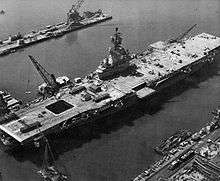
On 4 February 1946, Intrepid moved to San Francisco Bay. The carrier was reduced in status to "commission in reserve" on 15 August, and she was decommissioned on 22 March 1947. After her decommissioning, the Intrepid became part of the Pacific Reserve Fleet. On 9 February 1952, she was recommissioned and on 12 March began the voyage to Norfolk, where the carrier would receive SCB-27C modernization to operate jet aircraft as an attack aircraft carrier. On 9 April, the Intrepid was temporarily decommissioned for the modernization at the Norfolk Naval Shipyard. On 1 October, she was reclassified as attack carrier CVA-11 and recommissioned in reserve on 18 June 1954. On 13 October, the carrier became the first to launch aircraft with American-built steam catapults. Two days later, the Intrepid became part of the Atlantic Fleet in full commission.[1]
1955–1961

In 1955, Intrepid conducted her shakedown cruise out of Guantánamo Bay. On 28 May, she departed Mayport, Florida, for the first of two deployments in the Mediterranean with the 6th Fleet. The Intrepid returned to Norfolk from the second deployment on 5 September. On 29 September, she entered the New York Navy Yard for her SCB-125 modernization, which added an enclosed bow and an angled flight deck. After the end of the modernization in April 1957, Intrepid conducted refresher training out of Guantánamo Bay. In September, she participated in Operation Strikeback, the largest peacetime naval exercise up to that time in history, which simulated a Soviet attack on NATO. In December, operating from Norfolk, she conducted Operation Crosswind, a study of the effects of wind on carrier launches. The study proved that carriers could safely conduct flight operations without turning into the wind and even launch aircraft while steaming downwind. Between 1958 and 1961, Intrepid alternated Mediterranean deployments with operations along the Atlantic coast of the United States and exercises in the Caribbean.[1]
1962–1965
_-_Mar_65_a.jpg)
Intrepid was reclassified to an anti-submarine warfare carrier, CVS-11, on 8 December 1961. On 10 March 1962, the carrier entered the Norfolk Navy Yard for overhaul and refit for her new anti-submarine warfare role. After the completion of the overhaul and refit, she departed on 2 April with Carrier Antisubmarine Air Group 56 embarked. After training exercises, Intrepid was selected as the principal ship in the recovery team for astronaut Scott Carpenter and his Project Mercury space capsule, Aurora 7. Shortly before noon on 24 May 1962, Carpenter splashed down in Aurora 7 several hundred miles from Intrepid. Minutes after he was located by land-based search aircraft, two helicopters from Intrepid, carrying NASA officials, medical experts, Navy frogmen, and photographers, were airborne and headed to the rescue. One of the choppers picked him up over an hour later and flew him to the carrier which safely returned him to the United States. Intrepid spent the summer of 1962 training midshipmen at sea, and received a thorough overhaul at Norfolk in the fall.[1]
On 23 January 1963, the carrier departed Hampton Roads for warfare exercises in the Caribbean. In late February, she interrupted these operations to join a sea hunt for the Venezuelan freighter Anzoátegui, whose mutinous second mate had led a group of pro-Castro terrorists in hijacking the vessel. After the Communist pirates had surrendered at Rio de Janeiro, the carrier returned to Norfolk on 23 March. Intrepid operated along the Atlantic Coast for the next year from Nova Scotia to the Caribbean perfecting her antisubmarine techniques. On 11 June 1964, she left Norfolk carrying midshipmen to the Mediterranean for a hunter-killer at sea training with the 6th Fleet. While in the Mediterranean, Intrepid aided in the surveillance of a Soviet task group. En route home her crew learned that she had won the coveted Battle Efficiency "E" for antisubmarine warfare during the previous fiscal year. In the fall of 1964, the carrier operated along the East Coast. In early September, Intrepid entertained 22 NATO statesmen as part of their tour of U.S. military installations. Between 18–19 October 1964, the Intrepid was at Yorktown for ceremonies commemorating Lord Cornwallis's surrender 183 years before. The French Ambassador attended the ceremony and presented the U.S. with 12 cannon cast from molds found in the Bastille, replicas of those brought to American forces by Lafayette.[1]
On the night of 21 November, during a brief deployment off North Carolina, swift and efficient rescue procedures saved the life of an airman Jenner Sanders, who fell overboard while driving an aircraft towing tractor. In early 1965, Intrepid began preparations for a vital role in NASA's first manned Gemini flight, Gemini 3. On 23 March, Lieutenant Commander John Young and Major Gus Grissom in Molly Brown (the Gemini 3 spacecraft) splashed down some 50 nmi (90 km) from Intrepid after history's first controlled re-entry into the Earth's atmosphere ended the pair's nearly perfect three-orbit flight aboard Gemini 3. A Navy helicopter lifted the astronauts from the spacecraft and flew them to Intrepid for medical examination and debriefing. Later, Intrepid retrieved Molly Brown and returned the spacecraft and astronauts to Cape Kennedy.[1]
1965–1974
_-_Sep_66.jpg)
After this mission Intrepid entered the Brooklyn Navy Yard in April for a major overhaul to bring her back to peak combat readiness. This was the final Fleet Rehabilitation and Modernization job performed by the New York Naval Shipyard, Brooklyn, New York, which was scheduled to close. In September 1965, Intrepid, with her work approximately 75% completed, eased down the East River to moor at the Naval Supply Depot at Bayonne, New Jersey, for the completion of her multimillion-dollar overhaul. After builder's sea trials and fitting out at Norfolk she sailed to Guantánamo Bay, Cuba on a shakedown cruise.[1]
From April 1966 to February 1969, Intrepid made three Vietnam deployments, with Carrier Air Wing 10 embarked.[7] Mid-1966 found Intrepid with the Pacific Fleet off Vietnam. Nine A-4 Skyhawks and six A-1 Skyraiders, loaded with bombs and rockets, were catapulted in seven minutes, with only a 28-second interval between launches. A few days later planes were launched at 26-second intervals. After seven months of service with the United States Seventh Fleet off Vietnam, Intrepid returned to Norfolk having earned her Commanding Officer, Captain John W. Fair, the Legion of Merit for combat operations in Southeast Asia.[1]
On 9 October 1966 Lieutenant, junior grade William T. Patton of VA-176 from Intrepid, flying a propeller driven A-1H Skyraider, shot down one MiG-17. For the action, Lieutenant (jg) Patton was awarded the Silver Star.
In June 1967, Intrepid returned to the Western Pacific by way of the Suez Canal just prior to its closing during the Israeli-Arab crisis. There she began another tour with the Seventh Fleet.[1]
In 1968, Intrepid won the Marjorie Sterrett Battleship Fund Award for the Atlantic Fleet. For Carrier Air Wing 10's final cruise aboard Intrepid from 4 June 1968 to 8 February 1969 off Southeast Asia, the wing consisted of VF-111 Detachment 11 (F-8C), VA-106 with the A-4E, VA-66 Waldos (A-4C), VFP-63 Detachment 11 (RF-8G), VA-36 'Roadrunners' (A-4C), VAQ-33 Detachment 11 (EA-1F), VAW-121 Detachment 11 (E-1B), and HC-2 Detachment 11.[7]
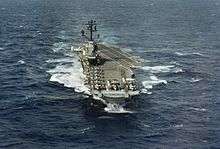
In 1969, Intrepid was home ported at Naval Air Station Quonset Point, Rhode Island, relieving Yorktown as the flagship for Commander Carrier Division 16. In the fall, the ship was run aground by Captain Horus E. Moore, but was freed within two hours. From April–October 1971, Intrepid took part in NATO exercises, and made calls in the North Atlantic and Mediterranean ports of Lisbon, Plymouth, Kiel, Naples, Cannes, Barcelona, Hamburg, Copenhagen, Greenock, Rosyth, Portsmouth, and Bergen. During this cruise, submarine detection operations were conducted in the Baltic and at the edge of the Barents Sea above the Arctic Circle, under close scrutiny of Soviet air and naval forces. She subsequently returned to her homeport to be refitted.
Beginning in July 1972, Intrepid participated once again in NATO exercises, visiting Copenhagen, Rotterdam, Bergen, Brussels, Portsmouth and Gourock. Intrepid found herself in the Barents and made round the clock flight operations as she was above the Arctic Circle. She cut her North Atlantic cruise short, returned to Quonset point for a mini-overhaul. She made her final cruise in the Mediterranean, stopping twice in Barcelona and Malaga Spain; Lisbon, Portugal; Nice, France; Naples, Italy; Palma, Majorca; and Piraeus, Greece once. Due to fuel limitations Intrepid spent as much time in port as she did underway.
On 15 March 1974, Intrepid was decommissioned for the final time.
Preservation as museum ship
|
USS Intrepid | |
|
Intrepid functioning as the Intrepid Sea-Air-Space Museum in New York City. | |
 | |
| Location | Intrepid Square, New York City |
|---|---|
| Coordinates | 40°45′53″N 74°00′04″W / 40.7648°N 74.0010°WCoordinates: 40°45′53″N 74°00′04″W / 40.7648°N 74.0010°W |
| Built | 1941 |
| Architect | Newport News Shipbuilding & Dry Dock |
| NRHP Reference # | 86000082 |
| Significant dates | |
| Added to NRHP | 14 January 1986[8] |
| Designated NHL | 14 January 1986[9] |
In 1976, Intrepid was moored at Philadelphia Naval Shipyard in Philadelphia and hosted exhibits as part of the United States Bicentennial celebrations.
Plans originally called for Intrepid to be scrapped after decommissioning, but a campaign led by real estate developers Zachary and Larry Fisher and the Intrepid Museum Foundation saved the carrier and established it as a museum ship. In August 1982, the ship opened in New York City as the Intrepid Sea-Air-Space Museum. Four years later, Intrepid was officially designated as a National Historic Landmark.[9][10]
Over the years, Intrepid has hosted many special events including wrestling events, press conferences, parties and the FBI operations center after the 11 September 2001 terrorist attacks.[11]
2006–2008 renovation
Throughout the last several years, the Intrepid museum has operated a fund for the restoration, raising over $60 million to refit Intrepid, to improve its exhibits for visitors, and improve Pier 86.

.jpg)
.jpg)
In early July 2006, it was announced that Intrepid would undergo renovations and repairs, along with Pier 86 itself. It closed on 1 October 2006, in preparation for its towing to Bayonne, New Jersey for repairs, and later Staten Island, New York for renovation and temporary docking.[12][13]
On 6 November 2006, an attempt to remove the aircraft carrier from the pier for restoration was temporarily put on hold by the Coast Guard. Despite the use of several tugs with a combined 30,000 hp (22,000 kW), officials said the ship was stuck in 24 years worth of accumulated silt and would not move.
On 11 November 2006, the United States Navy announced that it would spend $3 million to dredge the mud and silt from under Intrepid. The effort was led by the United States Navy Supervisor of Salvage and Diving with assistance from the United States Army Corps of Engineers, United States Coast Guard, and contractors. The teams operated for three weeks to clear the site of mud and silt.
On 5 December 2006, after the removal of 39,000 cu yd (30,000 m3) of muck from under the ship and around its four giant screws, Intrepid was successfully removed from its pier and was towed to Bayonne.[14]
Intrepid made a D-Day "landing" on Staten Island, 6 June 2007, after being towed from a slip at Bayonne Dry Dock & Repair Corp.
While in Staten Island, Intrepid underwent the next phase of her refurbishment, and received an $8 million interior renovation. Never-before-seen areas of the ship including the forecastle (fo'c'sle, commonly known as the anchor chain room), general berthing quarters and the ship's machine shop were opened to the public for the first time. The hangar deck features a new layout and design including new interactive exhibits. Around 1,200 tons of her original weight in steel were removed and 339 epoxy-coated steel pilings ranging in length from 60 to 183 feet were installed. Intrepid also received a new coat of paint, using almost 7,000 gallons to re-paint the interior, hull, towers, and decks. Total cost of the renovation was $120 million — $55 million for the ship and $65 million for Pier 86.[15]
The carrier was towed back into place on the Hudson River on 2 October 2008 and reopened to the public on 8 November.[15]
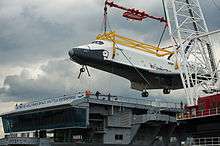
_(26699540111).jpg)
On 12 December 2011, ownership of the Space Shuttle Enterprise was officially transferred to the Intrepid Sea, Air & Space Museum in New York City.[16][17][18] In preparation for the anticipated relocation, engineers evaluated the vehicle in early 2010 and determined that it was safe to fly on the Shuttle Carrier Aircraft once again.[19] At approximately 9:40 am Eastern Daylight Time on 27 April 2012 Enterprise took off from Dulles International Airport en route to a fly-by over the Hudson River, New York's JFK International Airport, the Statue of Liberty, the George Washington and Verrazano-Narrows Bridges, and several other landmarks in the city; in an approximately 45-minute "final tour". At 11:23 am Eastern Daylight Time Enterprise touched down at JFK International Airport.[20]
The mobile Mate-Demate Device and cranes were transported from Dulles to the ramp at JFK and the shuttle was removed from the SCA overnight on 12 May 2012, placed on a specially designed flat bed trailer and returned to Hangar 12.[21] On 3 June a Weeks Marine barge took Enterprise to Jersey City. The Shuttle sustained cosmetic damage to a wingtip when a gust of wind blew the barge towards a piling.[22] It was hoisted 6 June onto the Intrepid Museum in Manhattan.[23]
The Enterprise went on public display on 19 July 2012, at the Intrepid Museum's new Space Shuttle Pavilion.[24]

Notable popular culture appearances
_(26699538621).jpg)
The story of the Intrepid's move was featured on the History Channel's Mega Movers program. The episode was titled "Intrepid: On the Move", and premiered 5 July 2007.
The ship has been featured in blockbuster films, including Aftershock: Earthquake in New York, the 2004 film National Treasure and the 2007 film I Am Legend.[25][26]
See also
- List of aircraft carriers
- List of aircraft carriers of the United States Navy
- List of World War II ships
- List of museum ships
References
- 1 2 3 4 5 6 7 8 9 10 "Intrepid IV (CV-11)". Dictionary of American Naval Fighting Ships. Navy Department, Naval History & Heritage Command. 22 July 2015. Retrieved 3 November 2016.
- ↑ Parker, Eloise (4 November 2008). "50 facts about the Intrepid: The floating museum is back after big renovation". New York Daily News. Retrieved 3 November 2016.
- ↑ White & Gandt 2008, p. 9.
- ↑ IntrepidMuseum.org, official website for the Intrepid Sea, Air and Space Museum, via https://www.intrepidmuseum.org/intrepidsjourney
- ↑ "U.S.S. INTREPID – handling of after Battle Damage.", Captain T. L. Sprague, USS Intrepid
- ↑ "Honoring our Heroes" (Press release). North Penn Reporter. 28 May 2004. Retrieved 2011-05-18.
- ↑ National Park Service (2007-01-23). "National Register Information System". National Register of Historic Places. National Park Service.
- 1 2 "INTREPID, USS (Aircraft Carrier)". National Historic Landmark summary listing. National Park Service. Retrieved 2008-01-26.
- ↑ Harry A. Butowsky (May 1985). "National Register of Historic Places Inventory-Nomination: USS Intrepid (CV-11)" (PDF). National Park Service. Retrieved 2009-06-22. and Accompanying 8 photos, exterior and interior, from 1982, 1983, 1984, and 1944. (1.27 MB)
- ↑ Milton, Pat (7 November 2006). "Mud Stops USS Intrepid Move From N.Y. Pier". The Washington Post. Retrieved 2007-03-21.
- ↑ "The Intrepid Will Be Temporarily Moved and Pier 86 Will be Reconstructed Under an Historic $55 Million-Plus Capital Expansion Plan". Intrepid Air, Sea and Space Museum. Archived from the original on 5 October 2006. Retrieved 2007-03-21.
- ↑ "Intrepid to Close for Repairs, Renovation". Marinelink.com. Retrieved 2007-03-21.
- ↑ "Briefly, Slowly, Intrepid Moves Again" – New York Times
- 1 2 Pyle, Richard, "Aircraft carrier survived wars, years of decay", Associated Press (printed in the Washington Times, p. 10), 30 September 2008.
- ↑ Pearlman, Robert Z (12 December 2011). "Intrepid Museum Celebrates Ownership of Space Shuttle Enterprise". CollectSpace. Retrieved 30 January 2012.
- ↑ "NASA Transfers Enterprise Title to Intrepid Sea, Air & Space Museum in New York City". NASA.gov. 11 December 2011. Retrieved 30 January 2012.
- ↑ "NASA Transfers Title to Space Shuttle Orbiter Enterprise to the Intrepid Sea, Air & Space Museum in New York City" (Press release). PRWeb. 22 November 2011. Retrieved 27 March 2012.
- ↑ Bergin, Chris (14 March 2010). "Enterprise in good condition for potential SCA ferry from Smithsonian NASM". NASAspaceflight.com. Retrieved 16 March 2010.
- ↑ Shamburger, Merideth. "In Photos: Enterprise Takes Flight Over Hudson". The Tarrytown Daily Voice. Retrieved 26 July 2012.
- ↑ Pearlman, Robert Z (1 March 2012). "Space shuttle Enterprise lands in New York City on April 23". CollectSPACE. Retrieved 22 March 2012.
- ↑ Ludka, Alexandra (5 June 2012). "Space Shuttle Enterprise Damaged On Way to New Home". ABC News. Retrieved 7 June 2012.
- ↑ "Enterprise to spend day in Jersey City". NJ.com. Associated Press. 4 June 2012. Retrieved 7 June 2012.
- ↑ Katz, Alex (18 July 2012). "Space shuttle Enterprise set to open to public". Bradenton Herald. Retrieved 18 July 2012.
- ↑ "INTREPID: ON THE MOVE A MEGA MOVERS SHOW".
- ↑ "Episode: Intrepid: On the Move".
- This article incorporates text from the public domain Dictionary of American Naval Fighting Ships. The entry can be found here.
Bibliography
- White, Bill; Robert Gandt; John McCain (2008). Intrepid: The Epic Story of America's Most Legendary Warship. Broadway. ISBN 0-7679-2989-6.
Further reading
- John Roberts (1982). The Aircraft Carrier Intrepid. Conway Maritime Press. ISBN 0-85177-251-X. Part of the "Anatomy of the Ship" series.
- McGeehan, Patrick (2 October 2008). "Floating Proudly, a Warship Returns to Its Mission". The New York Times.
- Fletcher, Gregory G (2012). Intrepid Aviators: The True Story of U.S.S. Intrepid's Torpedo Squadron 18 and Its Epic Clash With the Superbattleship Musashi. Penguin. ISBN 9780451236968.
External links
| Wikimedia Commons has media related to: |
- USS Intrepid Association - former crew members' website
- Photos of Intrepid - NavSource Online
- Intrepid Sea, Air & Space Museum
